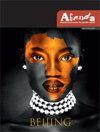Black common sense
IF 0.4
Q4 Arts and Humanities
引用次数: 0
Abstract
abstract This article explores ‘uhuru’ as a critical noun through a reading of the 2020 music video of Sun El-Musician (featuring Azana), ‘Not Yet Uhuru’. A form of rendition of Letta Mbulu’s (1993) ‘Not Yet Uhuru-Akhamandela’, various other echoes of this, conjured in Makhosazana Xaba’s (2019) poem of the same name, are double speak, elegy, repetition and onomatopoeic in action. One of its signifiers appears in the use of the biographical, with uses against a ‘knownness’ of iconographic Black figures, even while the music video appears in a space and time where a ‘new’ signifier of politics is conjured in the image of young black women. Turning to the figure of the Black femme as a belated figure of uhuru, Black common sense is an incursion on and against singular/linear time, os an ‘as is’ sensibility.黑人常识
摘要本文通过阅读孙埃尔音乐家(阿扎娜主演)2020年的音乐视频《还没有乌胡鲁》,探讨了“乌胡鲁”作为一个批评性名词的问题。Letta Mbulu(1993)的《Not Yet Uhuru Akhamandela》的一种演绎形式,以及Makhosazana Xaba(2019)的同名诗歌中所唤起的其他各种回声,都是双关语、挽歌、重复和拟声。它的一个能指出现在传记的使用中,与黑人形象的“已知性”相反,即使音乐视频出现在一个年轻黑人女性形象中唤起政治“新”能指的时空中。将黑人女性形象视为一个迟来的乌胡鲁形象,黑人常识是对奇异/线性时间的入侵和反对,是一种“原样”的感性。
本文章由计算机程序翻译,如有差异,请以英文原文为准。
求助全文
约1分钟内获得全文
求助全文

 求助内容:
求助内容: 应助结果提醒方式:
应助结果提醒方式:


